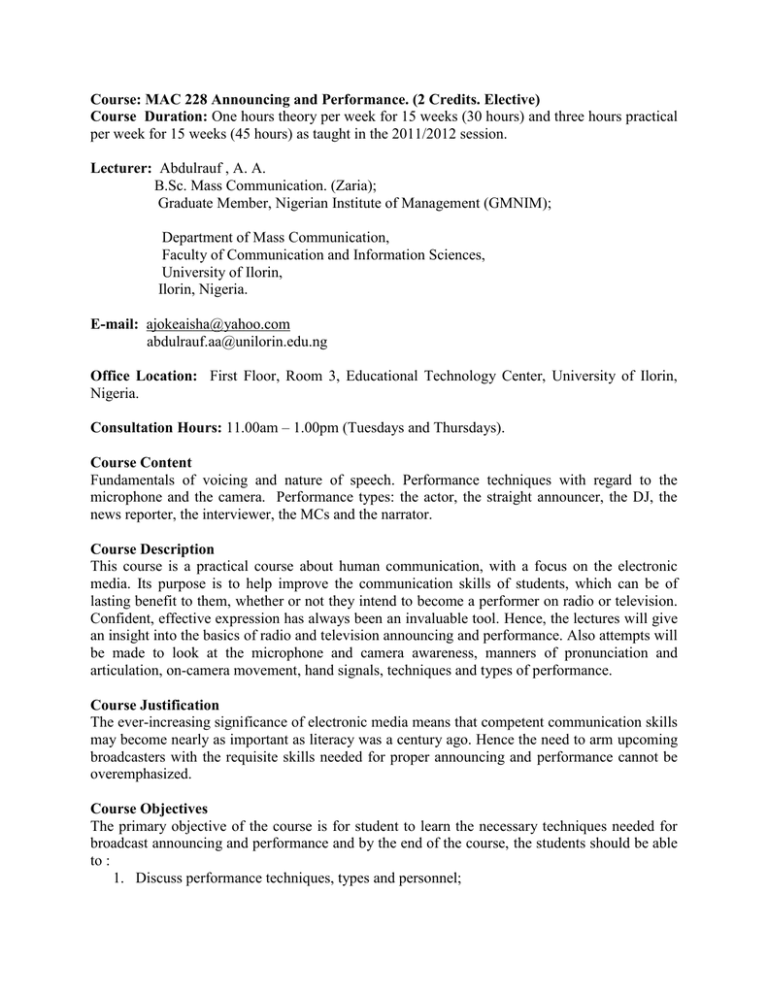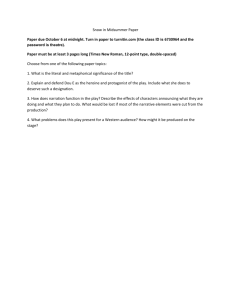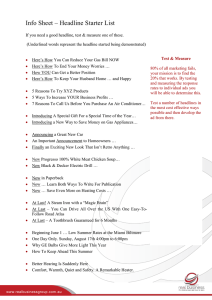Course: MAC 228 Announcing and Performance. (2 Credits. Elective) Lecturer:
advertisement

Course: MAC 228 Announcing and Performance. (2 Credits. Elective) Course Duration: One hours theory per week for 15 weeks (30 hours) and three hours practical per week for 15 weeks (45 hours) as taught in the 2011/2012 session. Lecturer: Abdulrauf , A. A. B.Sc. Mass Communication. (Zaria); Graduate Member, Nigerian Institute of Management (GMNIM); Department of Mass Communication, Faculty of Communication and Information Sciences, University of Ilorin, Ilorin, Nigeria. E-mail: ajokeaisha@yahoo.com abdulrauf.aa@unilorin.edu.ng Office Location: First Floor, Room 3, Educational Technology Center, University of Ilorin, Nigeria. Consultation Hours: 11.00am – 1.00pm (Tuesdays and Thursdays). Course Content Fundamentals of voicing and nature of speech. Performance techniques with regard to the microphone and the camera. Performance types: the actor, the straight announcer, the DJ, the news reporter, the interviewer, the MCs and the narrator. Course Description This course is a practical course about human communication, with a focus on the electronic media. Its purpose is to help improve the communication skills of students, which can be of lasting benefit to them, whether or not they intend to become a performer on radio or television. Confident, effective expression has always been an invaluable tool. Hence, the lectures will give an insight into the basics of radio and television announcing and performance. Also attempts will be made to look at the microphone and camera awareness, manners of pronunciation and articulation, on-camera movement, hand signals, techniques and types of performance. Course Justification The ever-increasing significance of electronic media means that competent communication skills may become nearly as important as literacy was a century ago. Hence the need to arm upcoming broadcasters with the requisite skills needed for proper announcing and performance cannot be overemphasized. Course Objectives The primary objective of the course is for student to learn the necessary techniques needed for broadcast announcing and performance and by the end of the course, the students should be able to : 1. Discuss performance techniques, types and personnel; 2. 3. 4. 5. Identify proper pronunciation , articulation and announcing; Describe camera and microphone consciousness and fright; Analyze the various hand and time signals and Discuss broadcast programme delivery. Course Requirements Student offering this course are required to: • Attend at least 75% of classes in the course punctually; • Participate in all course activities regularly; • Have a yahoo e-mail account, join and participate in an on-line discussion group dedicated to the course; • Word process all assignments and • Partake in all class practical. Methods of Grading Performance in the course will be graded using the guidelines in the table below. Criterion Practical Participation in on-line discussion Test Final Examination Total Percentage Score of Total Marks 15 05 10 70 100 Course Delivery Strategies The face-to-face method of lecture delivery strategy is adopted for the course. There will also be an on-line discussion forum for students’ participation and practical demonstrations. Lecture Contents Week I: Course Overview. Objectives The lecture will introduce the course and conceptualize the words announcing and performance; it will also demonstrate some announcing and performance characteristics. Description First Hour (Theory) An overview of the course and conceptualization. First Hour (Practical) Announcing. Second Hour (practical) Performance. Third Hour (practical) Differentiate between announcing and performance. Study Questions 1. Why is broadcast announcing and performance important? 2. Define the word ‘announcing’? 3. Demonstrate a speech showing announcing characteristics. 4. What is performance? 5. Demonstrate a speech showing some performance characteristics. Reading List 1. Hyde 2, S. (1998). Television and Radio Announcing (8th ed).United States of America: Houghton Mifflin Company. ISBN 0-395-87540-4. 2. Onabajo 2, O. (2000). Announcing and Performance. Lagos, Nigeria: Gabi Concept Limited. ISBN 978-35025-6-5. Week 2: Announcing for the Electronic Media. Objectives The lecture will take a holistic look at announcing for the electronic media as well as demonstrate the types of announcing. Description First hour (Theory) Announcing. First Hour (Practical) Announcing for radio. Second Hour (Practical) Announcing for television. Third Hour(Practical) Announcing. Study Questions 1. Who is an announcer? 2. List the type of announcing you know. 3. Explain three types of announcing. 4. Demonstrate two types of announcing. 5. Differentiate between announcing and announcer. Reading List 1. Hyde 2, S. (1998). Television and Radio Announcing (8th ed).United States of America: Houghton Mifflin Company. ISBN 0-395-87540-4. 2. Onabajo 2, O. (2000). Announcing and Performance. Lagos, Nigeria: Gabi Concept Limited. ISBN 978-35025-6-5. Week 3: Voicing Objectives The lecture will explain voicing and its fundamentals as well as demonstrate them. It will lay emphasis on making pleasant speech sound, clearly articulating the sound of English language, Varying pitch and volume effectively, pronouncing words according to accepted standards and communication ideas clearly orally. Description First Hour (Theory) Voicing. First Hour (Practical) Voicing of vowels. Second Hour (Practical) Voicing of consonants (Manner of articulation). Third Hour (Practical) Voicing of vowels and consonants (Place of articulation). Study Questions 1. List five classification of speech sound. 2. Explain two classification of speech sound. 3. What are the two broad categories of consonants? 4. What are the fundamentals of voicing? 5. Name the subdivisions of consonants. 6. Using relevant alphabet demonstrates the pronunciation of different types of consonant. Reading List 1. Hyde 2, S. (1998). Television and Radio Announcing (8th ed).United States of America: Houghton Mifflin Company. ISBN 0-395-87540-4. 2. Onabajo 2, O. (2000). Announcing and Performance. Lagos, Nigeria: Gabi Concept Limited. ISBN 978-35025-6-5. Week 4: Pronunciation and Articulation. Objectives This lecture seeks to explore and demonstrate proper pronunciation and articulation as well as examine their differences. Description First Hour Pronunciation and articulation. First Hour (Practical) Articulation. Second Hour (Practical) Pronunciation. Third Hour (Practical) Difference between articulation and pronunciation. Study Questions 1. What are the causes of mispronunciation? 2. How can pronunciation be improved among Nigerian broadcasters? 3. Define articulation? 4. What is pronunciation? 5. Differentiate between articulation and pronunciation. Reading List 1. Hyde 2, S. (1998). Television and Radio Announcing (8th ed).United States of America: Houghton Mifflin Company. ISBN 0-395-87540-4. Week 6: Broadcast Delivery. Objectives The lecture will examine and demonstrate the proper way to deliver broadcast programmes how broadcast programmes should be presented. It will also explore the elements of programme delivery. Description First Hour Broadcast delivery. First Hour (Practical) Delivery. Second Hour (Practical) Elements of delivery. Third Hour (Practical) Voice modulation. Study Questions 1. What is voice modulation? 2. Explain the 6 variations of voice modulation. 3. Define the term delivery? 4. What are elements of delivery? 5. List 5 elements of delivery you know. Reading List 1. Hyde 2, S. (1998). Television and Radio Announcing (8th ed).United States of America: Houghton Mifflin Company. ISBN 0-395-87540-4. Week 7: Practical and Theory Test. Objectives To conduct a one- hour each continuous assessment and practical test based on what was taught from week 1 to 6. Description First Hour Theory Assessment Test. Second Hour Practical assessment test. Study Questions As listed in week 1 to 6 Reading List 1. Hyde 2, S. (1998). Television and Radio Announcing (8th ed).United States of America: Houghton Mifflin Company. ISBN 0-395-87540-4. 2. Onabajo 2, O. (2000). Announcing and Performance. Lagos, Nigeria: Gabi Concept Limited. ISBN 978-35025-6-5. Week 8: Broadcast Performance. Objectives The lecture will explore the concept of broadcast performance; it will also examine and demonstrate different forms of performance. Description First Hour (Theory) Broadcast Performance. First Hour (Practical) Talk programmes and magazine programmes. Second Hour Practical) Drama programmes. Third Hour (Practical) Musical programmes. Study Questions 1. What are the different types of talk programmes. 2. State and discuss the variations of performance 3. Explain in details the concept of performance. 4. List the different classification of music in Nigeria. 5. Citing various local examples explain the meaning of light entertainment programmes. Reading List 1. Hyde 2, S. (1998). Television and Radio Announcing (8th ed).United States of America: Houghton Mifflin Company. ISBN 0-395-87540-4. 2. Onabajo 2, O. (2000). Announcing and Performance. Lagos, Nigeria: Gabi Concept Limited. ISBN 978-35025-6-5. Week 9: Performance Techniques Objectives The lecture will explain and demonstrate the skills required for effective performance; it will also explore the different types of performance techniques. Description First Hour (Theory) Performance techniques. First Hour (Practical) Performance techniques. Second Hour (Practical) Performance techniques. Third Hour (Practical) Performance techniques. Study Questions 1. What are performance techniques? 2. List 5 types of performance techniques. 3. Explain 2 types of performance techniques. 4. Define the term rehearsals? 5. What are the types of rehearsal we have? 6. The art of questioning is a performance technique which is very important for talk programmes. Discuss? Reading List 1. Onabajo 2, O. (2000). Announcing and Performance. Lagos, Nigeria: Gabi Concept Limited. ISBN 978-35025-6-5. Week 10: Types of Performance. Objectives The lecture will examine and practicalize different types of broadcast performance. Description First Hour (Theory) Types of performance First Hour (Practical) The narrator. Second Hour (Practical) The newscaster Third Hour (Practical) The announcer. Study Questions 1. State all the types of performance you know? 2. Explain any two from the types of performance listed above. 3. Justify the classification of a Master of Ceremony (MC) as a type of performance. 4. Differentiate between a reporter and a newscaster? 5. Who is a programme presenter and what types of programme does he present? Reading List 1. Hausman4, C., Messere, F. & Benoit P. (2007). Modern Radio Production. Production, Programming and Performance. (7th ed). Belmont, United States of America: Thompson Wardsworth, pp. 319-321. ISBN 0-495-05031-8 2. Onabajo 2, O. (2000). Announcing and Performance. Lagos, Nigeria: Gabi Concept Limited. ISBN 978-35025-6-5. Week 11: Performance Personnel. Objectives The lecture will examine those responsible for carrying out broadcast performance activities; it will also continue with the demonstration of types of performance. Description First Hour (Theory) Performance personnel. First Hour (Practical) The interviewer. Second Hour (Practical) The reporter. Third Hour (Practical) The programme presenter. Study Questions 1. Distinguish between the following: a. Studio manager and studio engineer, b. A producer and a director, c. graphic artist and makeup artist and d. floor manager and set designer. 2. State two ways, in which makeup can be used. 3. List 5 types of performance personnel. 4. Who is a video tape editor? 5. What are the duties of a video tape editor? Reading List 1. Hyde 2, S. (1998). Television and Radio Announcing (8th ed).United States of America: Houghton Mifflin Company. ISBN 0-395-87540-4. 2. Onabajo 2, O. (2000). Announcing and Performance. Lagos, Nigeria: Gabi Concept Limited. ISBN 978-35025-6-5. Week 12: Microphone and Camera Fright. This lecture will examine the causes and solution to microphone and camera fright as well as continue the demonstration for types of performance. Description First Hour (Theory) Microphone and camera fright. First Hour (Practical) The sports commentator. Second Hour ( Practical) The Master of Ceremony. Third Hour (Practical) The Disc Jockey Study Questions 1. What do you understand by the terms microphone? 2. What are the causes of Microphone and camera fright? 3. Differentiate between microphone and camera fright. 4. Rehearsals are very important in any performance. Discuss. 5. Define camera fright. Reading List 3. Hyde 2, S. (1998). Television and Radio Announcing (8th ed).United States of America: Houghton Mifflin Company. ISBN 0-395-87540-4. 4. Onabajo 2, O. (2000). Announcing and Performance. Lagos, Nigeria: Gabi Concept Limited. ISBN 978-35025-6-5. Week 13: Microphone and Camera Consciousness. Objectives The lecture will explain the improper use of microphone and camera in a broadcast presentations as well as demonstrate their proper usage. Description First Hour (Theory) Microphone and camera consciousness. First Hour (Practical) Microphone consciousness. Second Hour (Practical) Camera consciousness. Third Hour (Practical) On camera movement. Study Questions 1. What do you understand by the term microphone consciousness? 2. Identify some examples of not being microphone conscious? 3. What is camera consciousness? 4. The camera could be likened to the human eye. Discuss. 5. List and explain some of the camera movements you have learnt in this course? 6. What do you understand by the following: a. Telegraphing movement and b. Cheating to the camera. Reading list 1. Hyde 2, S. (1998). Television and Radio Announcing (8th ed).United States of America: Houghton Mifflin Company. ISBN 0-395-87540-4. 2. Onabajo 2, O. (2000). Announcing and Performance. Lagos, Nigeria: Gabi Concept Limited. ISBN 978-35025-6-5. Week 14: Hand and Time Signals. Objectives This lecture will explore and demonstrate the various hand and time signals used in broadcast performance. Description First Hour (Theory) Hand and time signals. First Hour (Practical) Hand signals. Second Hour (Practical) Hand signals (cont’d) Third Hour (Practical) Time signals Questions 1. List 8 hand signals you know. 2. What are time signals? 3. Why are time signals important? 4. Explain any two time signals. 5. Differentiate between hand and time signals. 6. State the most important similarity between hand and time signal. Reading list 1. Onabajo 2, O. (2000). Announcing and Performance. Lagos, Nigeria: Gabi Concept Limited. ISBN 978-35025-6-5. Week 15: Revision. Objectives This lecture takes a look at what has been taught in the past fourteen weeks. Attempts will be made to throw more light on issues that demand clarification, entertain opinions and questions in preparation for exams. Description First Hour Revision. Second Hour Revision. Revision Questions. 1. What is the relevance of voice modulation to contemporary broadcast announcing and performance? 2. Explain in details the classification of consonants under the following heading: i. Manner of articulation. ii. Place of articulation. 3. What are the similarities between hand and time signals? 4. Miss Mojisila Adeyemi has just being employed as an announcer for Kwara TV, Ilorin. She has been assigned to the News desk. As a broadcast scholar advice her on the qualities she must possess to aid her delivery of programmes in the station. 5. List the types of performance you know. 6. Illustrate with relevant examples, the different types of talk programmes obtainable in broadcast performance. 7. Describe the basic time signals used in broadcast programming and what they indicate. 8. What conditions cause microphone or camera fright in broadcast announcing and performance? 9. What solutions can you suggest to overcome this fright? 10. Why is proper articulation and pronunciation important in broadcast announcing and performance? 11. Why is a good performance indispensable in broadcasting? Reading List. 1. Hausman, C., Messere, F. & Benoit P. (2007). Modern Radio Production. Production, Programming and Performance. (7th ed). Belmont, United States of America: Thompson Wardsworth, pp. 319-321. ISBN 0-495-05031-8 2. Onabajo 2, O. (2000). Announcing and Performance. Lagos, Nigeria: Gabi Concept Limited. ISBN 978-35025-6-5. 2 3. Hyde , S. (1998). Television and Radio Announcing (8th ed).United States of America: Houghton Mifflin Company. ISBN 0-395-87540-4. Key 12345- Available in the University Library. Available in Local Bookshops. Available on the Web. Personal Collections. Departmental Library.

